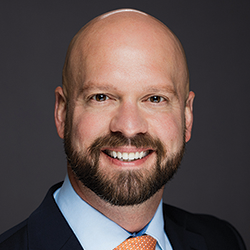
Voice of the President | January 2023
Happy New Year! I can hardly believe I’m starting my second year as AONL’s President. I knew when I stepped into the role that time would fly, but 2022 has truly moved at warp speed! AONL started off the year with a refreshed strategic plan aimed at helping nurse leaders confront the pressures we’re facing related to workforce shortages, unprecedented health care worker burnout and financial constraints. I want to take just a moment to highlight some of last year’s accomplishments.

In January, we released our new guiding principles on diversity, equity, inclusion and belonging. These principles are the linchpin for nurse leaders in supporting and promoting environments where everyone can thrive. We also revised our nominations process and presented our most diverse slate of candidates to date. In 2023, our DEIB Committee plans to offer a self-assessment tool for leaders to identify gaps in DEIB efforts in their organizations or units. A companion toolkit will support leaders as they work to improve identified gap areas.
Last year also marked the launch of AONL’s Workforce Committee. This team convened with a focus on engaging, retaining and reimaging the work of nurse leaders to help us with tackling the challenges we’re confronting every day. This committee has had tremendous momentum and accomplished a great deal in the last 12 months. Thanks to the committee’s dedication, in November AONL released the first section of a three-part compendium. This valuable compilation offers practical solutions and examples from AONL members describing how they’ve confronted workforce challenges in talent attraction, recruitment and retention. Upcoming chapters will address other key topics including leadership, academic-clinical partnerships, positive practice environments, culture of inquiry and compensation and benefits.
In alignment with our strategic priority to advance nursing leadership, we’ve released AONL Nurse Leader Core Competencies and the Nurse Leader Competencies Model. These newly published competencies are for all nurse leaders, from emerging leaders to experienced executives. The model represents the core leadership domains and emphasizes the importance of the Leader Within as an anchor to the other five core domains: business skills and principles; communication and relationship building; knowledge of the health care environment; professionalism and leadership.
Another important 2022 example I’ll showcase is the fourth AONL Foundation Longitudinal Nursing Leadership Insight Study. The initial phase of this study began in July 2020, during the heart of the pandemic. The series has been used by leaders across the globe to objectively demonstrate the issues facing nurse leaders. The most recent results are highlighted in this edition of Voice. In part, they reveal that while the emotional health and well-being of nurse leaders has slightly improved, it remains the top issue facing us today. Other items of concern are staff retention, cost of travel nursing and workplace violence.
One of my favorite additions to this year’s study asks leaders how much time they are spending on specific tasks each week. Then, using those same tasks, leaders identify which tasks frustrate them and which bring them joy. By examining the results of these three questions we can identify where we might eliminate low-value, high-stress tasks and invest more time and energy into the work that lifts our spirits. The ultimate goal is to reshape the nurse leader’s day to be more fulfilling and rewarding.
In addition to the Longitudinal Nursing Leadership Insight Study, we’ve got some great articles included in this Voice edition focused on public health nursing. The last few years have exposed some of the nation’s vulnerabilities and highlighted the benefits of having a strong public health infrastructure. The U.S. Department of Health and Human Services defines social determinants of health as the conditions in the environments where people are born, live, learn, work, play, worship and age that affect a wide range of health, functioning and quality-of-life outcomes and risks.
Public health nurses, embedded within a community, have the ability to build trusting relationships and impact the health of entire populations . . .
Years of data and research are concluding that our environments impact our health and play a significant role in predicting overall well-being. In fact, up to 60% of health is determined by ZIP code rather than genetic code. Public health nurses, embedded within a community, have the ability to build trusting relationships and impact the health of entire populations – and that is just what the authors of this month’s articles are doing.
I am awestruck by the authors’ individual journeys and by the breadth and depth of their impact. Their initiatives are far ranging: addressing food insecurities, vaccinating homeless populations and using genomics for early mitigation of serious illnesses. Everything they do has the goal of improving the health of the disadvantaged and in turn, enriching patients’ lives.
The National Academy of Medicine’s report, The Future of Nursing 2020-2030: Charting a Path to Achieve Health Equity calls for action and improvements in clinical care, nurse education, nursing leadership and nursing-community partnerships. This report provides a road map for nurse leaders to navigate a path forward in improving the health of individuals, families and communities with social determinants of health. It emphasizes the role and impact of nurses working in public health, addressing the social determinants of health and transforming patient care outside of health care settings. The authors of this issue’s articles are pioneers already paving the way!


